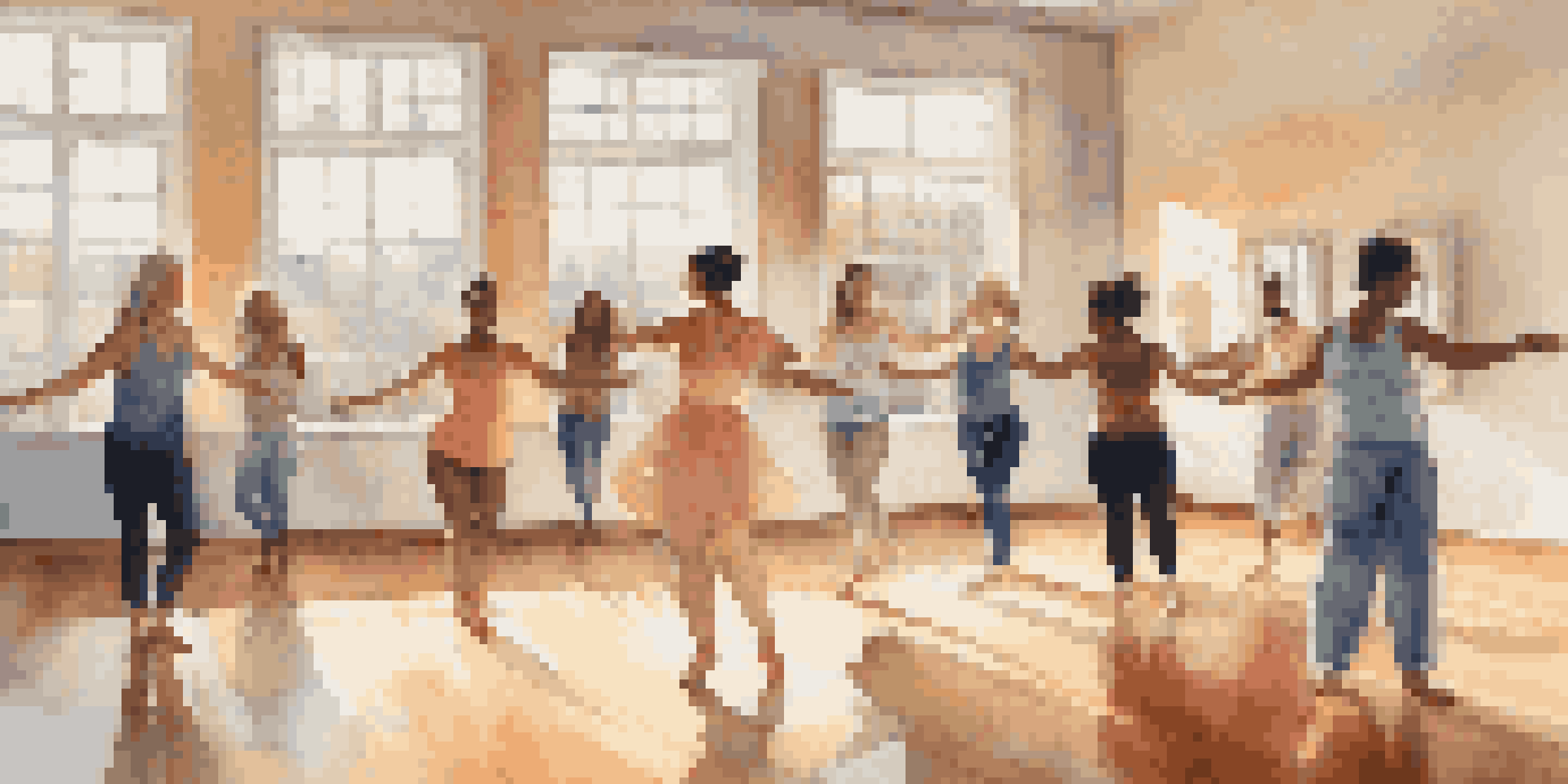Dance Therapy for Depression: Movement as a Healing Tool

Understanding Dance Therapy and Its Benefits
Dance therapy is a form of expressive therapy that uses movement to promote emotional, cognitive, and physical integration. It’s based on the idea that movement and emotion are interconnected, allowing individuals to express feelings that might be difficult to articulate verbally. By engaging in dance, participants can explore their emotions in a safe and nurturing environment.
Dance is the hidden language of the soul.
The benefits of dance therapy extend far beyond mere enjoyment. Studies have shown that it can help reduce symptoms of depression and anxiety, improve self-esteem, and enhance overall well-being. For many, dance becomes a transformative experience, helping individuals reconnect with their bodies and emotions in a positive way.
Moreover, dance therapy fosters a sense of community. Group sessions often create a supportive atmosphere where participants feel connected to others, reducing feelings of isolation. This social interaction can be particularly beneficial for those struggling with depression, as it encourages them to share their experiences and support one another.
The Science Behind Movement and Mood
Research has shown a strong link between physical activity and mental health. When we move, our bodies release endorphins, which are natural mood lifters that can lead to a sense of euphoria often referred to as the 'runner's high.' Dance therapy harnesses this biological response, using movement as a catalyst for emotional healing.

Additionally, dance therapy engages both the body and mind. It encourages mindfulness, as participants focus on their movements and feelings in the moment. This mindfulness can help individuals break the cycle of negative thoughts that often accompany depression, allowing them to experience joy and fulfillment through movement.
Dance Therapy Enhances Well-being
Engaging in dance therapy can significantly reduce symptoms of depression and anxiety while promoting emotional and physical integration.
The rhythmic nature of dance also plays a crucial role in enhancing mood. Rhythmic movements can stimulate the brain's reward system, creating a sense of pleasure and satisfaction. This can be especially important for those dealing with depression, as it encourages them to seek out positive experiences and rediscover the joy of living.
How Dance Therapy Sessions Are Structured
Dance therapy sessions typically begin with a warm-up, allowing participants to relax and connect with their bodies. This phase may include stretching, breathing exercises, and gentle movements that promote physical awareness. The warm-up sets a comfortable tone, encouraging participants to express themselves freely.
The dance is a poem of which each movement is a word.
Following the warm-up, the therapist introduces structured dance activities, which may include improvisation or guided movements based on the participants' emotional needs. These activities are designed to facilitate self-expression and exploration, enabling individuals to connect with their inner selves and release pent-up emotions.
Finally, sessions often conclude with a cool-down period that allows participants to reflect on their experiences. This debriefing is essential, as it gives individuals the chance to share their feelings and insights with the group, fostering a sense of connection and understanding among participants.
Real-Life Success Stories of Dance Therapy
Many individuals have found solace in dance therapy, sharing inspiring stories of transformation. For instance, one participant, who had struggled with depression for years, discovered a renewed sense of joy through movement. By expressing her emotions through dance, she was able to confront her feelings and gradually overcome her depressive symptoms.
Another success story highlights how dance therapy helped a young man reconnect with his passion for life. Initially skeptical, he found that engaging in dance allowed him to express emotions he had long suppressed. With time, he reported feeling lighter and more hopeful, showcasing the profound impact dance therapy can have on mental health.
Movement Boosts Mood and Mindfulness
The act of dancing releases endorphins, fostering a sense of joy and encouraging mindfulness that helps break negative thought cycles.
These stories illustrate that healing through dance is not just theoretical; it's a lived experience for many. The joy and empowerment that come from movement can inspire others facing similar struggles, encouraging them to explore dance as a viable tool for overcoming depression.
Finding the Right Dance Therapist for You
When considering dance therapy, it's important to find a qualified therapist who understands your unique needs. Look for someone who is trained in both dance and therapy, as this combination is crucial for effective healing. Many therapists offer introductory sessions, which can help you gauge their approach and see if it's a good fit.
Personal rapport is vital in any therapeutic setting. You should feel comfortable and supported in your sessions, as this creates a safe space for emotional exploration. Don’t hesitate to ask questions about their methods and experience to ensure that you’re aligning with a therapist who resonates with you.
Lastly, consider the environment where therapy takes place. A welcoming and inclusive space can greatly enhance your experience. Whether in a studio or community center, a positive atmosphere can make all the difference in how you connect with the practice and your therapist.
Incorporating Dance into Your Daily Routine
In addition to attending therapy sessions, integrating dance into your daily routine can further enhance your mental health. Even simple movements, like swaying to your favorite music in your living room, can uplift your spirits and provide an emotional release. The key is to find joy in movement, no matter how small.
Consider setting aside a few minutes each day for spontaneous dance breaks. Whether it’s dancing while cooking or during a brief work break, these moments can help you reconnect with your body and lift your mood. It doesn’t have to be choreographed; the focus should be on enjoying the movement.
Community Support in Dance Therapy
Group sessions in dance therapy create a supportive environment, helping participants connect with others and reducing feelings of isolation.
Lastly, joining a local dance class or group can foster a sense of community and support. Engaging with others who share a passion for dance can create connections that enhance emotional well-being. Dance, in any form, encourages joy and expression, making it a valuable tool for anyone seeking to improve their mental health.
The Holistic Benefits of Dance Therapy
Dance therapy offers a holistic approach to mental health, addressing not only emotional but also physical and social aspects of well-being. By engaging in dance, individuals can experience improved physical fitness, enhanced coordination, and greater body awareness. This physical engagement often leads to increased confidence and self-image.
Moreover, dance therapy encourages creativity and self-expression, allowing individuals to tap into their artistic side. This creative outlet can be particularly beneficial for those struggling with depression, as it provides a way to communicate feelings that may be difficult to express otherwise. Expressing oneself through movement can be liberating and empowering.

Finally, the supportive community fostered in dance therapy can create lasting connections. Participants often form friendships that extend beyond the sessions, providing a network of support that can be invaluable in the healing process. This sense of belonging can significantly reduce feelings of loneliness and isolation, further enhancing mental wellness.